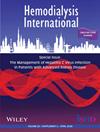Outcomes of operative intervention for ulcers over hemodialysis arteriovenous access
Abstract
Introduction
The native arteriovenous fistula (AVF) is the gold standard for long-term hemodialysis access. When native vein options are exhausted, arteriovenous graft (AVG) becomes the next choice. An ulcer over an AVF or AVG is a serious condition with the potential for life-threatening hemorrhage.
Objectives
This study aims to present our experience with surgical management of ulcers over AVFs or AVGs.
Materials and Methods
Electronic records of 26 patients who underwent 27 consecutive surgical procedures for ulcers over AVFs or AVGs from December 31, 2016 to December 31, 2021 at the Royal Liverpool University Hospital were retrospectively analyzed.
Results
The majority were males (14/26, 53.8%) and the median age was 64.5 years. Operative repair was required for 25 ulcers over 24 AVFs and 2 ulcers over 2 AVGs. Ten patients (37%) presented with bleeding. Seventeen (63%) had impending bleeding suggested by a thin soft tissue covering or a false aneurysm at the site of the ulcer. Previous endovascular intervention for fistula outflow stenosis was a significant predictor for presenting with bleeding (p = 0.031). All ulcers (27/27, 100%) underwent excision and primary skin closure. Fistula wall defects were directly repaired in 18/27 (66.7%). Four/26 (14.8%) fistulas had to be ligated and 2 (7.4%) had end-to-end re-anastomosis after excision of damaged segments. Three/26 (11.53%) fistulas thrombosed immediately after the intervention. The overall fistula salvage rate was 73.08% (19/26). There was 1 (3.7%) patient mortality due to bleeding from wound breakdown after surgery.
Conclusions
An acceptable fistula salvage rate can be expected following surgical repair of ulcers over AVFs and AVGs. A history of previous endovascular interventions for fistula outflow stenosis was a predictor of bleeding from these ulcers.

 求助内容:
求助内容: 应助结果提醒方式:
应助结果提醒方式:


